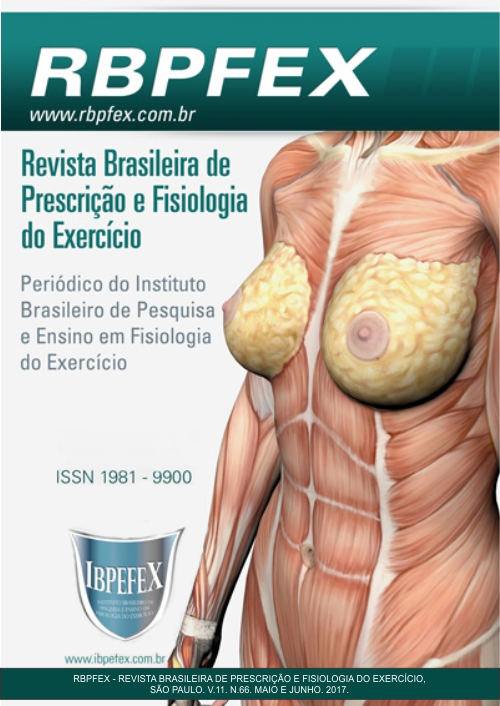Comparison of cardiovascular changes during the practice of active video games: standing and sitting in wheelchairs
Abstract
Objective: To evaluate and compare the hemodynamic responses of individuals to different forms of practice (standing and wheelchairs - 15 minutes) with active video games. Methods: Two sessions were held (standing and sitting) of the same Xbox 360 game console with Kinect®, Kinect Sports: Boxing. 20 subjects were monitored for heart rate and blood pressure (rest [HRres/BPres], immediately after [HRia/BPia] and five minutes after [HR/BP]). Data were tested by ANOVA Two-Way. Results: The HR found significant differences in the situation in standing: HRres-FC5' elevation (p=0.000) and reduced HRia-HR5' (p=0.000). In the sitting position, significant rise HRres-FCia(p=0.000) and HRres-FC5' (p=0.000). The BP was found significant elevation between BPres-BPia (p=0.000) and reduced BPia-BP5' (p=0.000) standing. Sitting, lifting BPres-BPia (p=0.012). Discussion: The effects of hemodynamic variables and inotropic answered in the normal way on the characteristic controlled stress of exercise. Compared Brito and Souza and his answers were similar, with the increase of variables FC and PAS. Conclusion: The practice of VGA's bring significant differences in hemodynamic and inotropic variables in the traditional position or in a wheelchair. It can be used as a therapeutic tool.
References
-Adamo, K. B.; Rutherford, J. A.; Goldfield, G. S. Effects of interactive video game cycling on overweight and obese adolescent health. Applied Physiology, Nutrition, and Metabolism. V. 35. Num. 6. 2010. P. 805-815.
-Astrand, P. O.; Ryhming, I. A. Nomogram for Calculation of Aerobic Capacity (Physical Fitness) From Pulse Rate During Submaximal Work. Journal of Applied Physiology. Vol. 7. 1954. p. 218-221.
-Bosch, P. R.; Poloni, J.; Thornton, A.; Janes, V. L.The Heart Rate Response to Nintendo Wii Boxing in Young Adults. Vol. 23. Núm. 2. 2012.
-Christie B.; Trout J. Rather than contribute to a sedentary lifestyle, these games demand activity from the players. Interactive Video Game Physical Education. Vol. 5. 2007. p. 78.
-Graves, L.;Stratton, G.; Ridgers, N. D.; Cable, N. T. Comparison of energy expenditure in adolescents when playing new generation and sedentary computer games: cross sectional study. BMJ (Clinical research ed.). Vol. 335. 2007.
-Haskell,W. L.; Lee, I. M.; Pate, R. R.; Powell, K. E.; Blair, S. N.; Franklin, B. A.; Bauman, A. Physical activity and public health: updated recommendation for adults from the American College of Sports Medicine and the American Heart Association. Circulation. Vol. 116. Num. 9. 2007. p. 93.
-Healy, G. N.; Winkler, E. A. H.; Owen, N.; Anuradha S.; Dunstan, D. W. Replacing sitting time with standing or stepping: associations with cardio-metabolic risk biomarkers. European Heart Journal. 2015.
-Hoffman, M. D. Cardiorespiratory Fitness and Training in Quadriplegics and Paraplegics. Sports Medicine. Vol. 3. Num. 5. 1986. p. 312-330.
-Kraemer, W. J.; Fleck, S. J.; Deschenes, M. R. Fisiologia do exercício: Teoria & prática. Rio de Janeiro. Guanabara Koogan. 2013.
-McArdle, W. D.; Katch, F. I.; Katch, V. L. Fisiologia do exercício: Energia, nutrição e desempenho humano. 7ª edição. Rio de Janeiro. Editora Guanabara Koogan. 2011.
-Melo, R. J. P.; Gomes, J. L. B.; Oliveira, S. F. M.; Costa, M. C. Acute hemodynamic responses following a training session with active video game in wheelchair. Cadernos de Terapia Ocupacional da UFSCar. Vol. 24. Num. 2. 2016.
-Mills, A.; Rosenberg, M.; Stratton, G.; Carter, H. H.; Spence, A. L.; Pugh, C. J.; Naylor, L. H. The Effect of Exergaming on Vascular Function in Children. The Journal of pediatrics. Vol.16. Num. 3. 2013. p. 1-5.
-Myers, J.; Lee, M.; Kiratli, J. Cardiovascular disease in spinal cord injury: an overview of prevalence, risk, evaluation, and management. American Journal Physical Medicine Rehabilitation. Num. 86. 2007. p. 142-152.
-Perrier-Melo, R. J.; Brito-Gomes, J. L.; Oliveira, S. F. M.; Costa, M. C. Acute responses of heart rate and blood pressure in a session of games of active video games in young health males: a pilot study. Revista Terapia Ocupacional da Universidade de São Paulo. Vol. 24. Num. 3. 2013. p. 259-266.
-Souza, R. A.; Cruz, L. G.; Carvalho, L. S.; Silva, F. F.; Carvalho, W. R. G. Acute cardiovascular responses in a virtual environment simulated by Nintendo Wii. Revista Brasileira de Cineantropometria e Desempenho Humano. Vol. 15. 2013. p. 60.
Authors who publish in this journal agree to the following terms:
- Authors retain the copyright and grant the journal the right of first publication, with work simultaneously licensed under the Creative Commons Attribution License BY-NC which allows the sharing of the work with acknowledgment of the authorship of the work and initial publication in this journal.
- Authors are authorized to enter into additional contracts separately for non-exclusive distribution of the version of the work published in this journal (eg, publishing in institutional repository or book chapter), with acknowledgment of authorship and initial publication in this journal.
- Authors are allowed and encouraged to post and distribute their work online (eg, in institutional repositories or on their personal page) at any point before or during the editorial process, as this can bring about productive change as well as increase impact and impact. citation of published work (See The Effect of Free Access).






